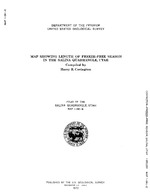
Map showing length of freeze-free season in the Salina quadrangle, Utah
Links
- Plate: Map 591-E (8.48 MB pdf)
- Cover: Folio Cover (38 KB pdf)
- NGMDB Index Page: National Geologic Map Database Index Page (html)
- Download citation as: RIS | Dublin Core
Abstract
In general, long freeze-free periods occur at low elevations, and short freeze-free periods occur at high elevations. But some valley floors have shorter freeze-free seasons than the glancing foothills because air cooled at high elevations flows downward and is trapped in the valleys. This temperature pattern occurs in the western part of the quadrangle in Rabbit Valley, Grass Valley, and the Sevier River Valley near Salina.
Because year-round weather stations are sparse in Utah, a special technique for estimating length of freeze-free season was developed by Dr. Gaylen L. Ashcroft, Assistant Professor of Climatology, Utah State University, and E. Arlo Richardson, State Climatologist, U.S. Weather Bureau, based on average annual temperature, average annual temperature range, average daily temperature range, and average july maximum temperature. This technique was used in preparation of the map showing “Length of 32°F freeze-free season for Utah,” figure 23 in Hydrologic Atlas of Utah (Utah State University and Utah Division of Water Resources, 1968), from which the data for this map were taken.
Study Area
| Publication type | Report |
|---|---|
| Publication Subtype | USGS Numbered Series |
| Title | Map showing length of freeze-free season in the Salina quadrangle, Utah |
| Series title | IMAP |
| Series number | 591 |
| Chapter | E |
| DOI | 10.3133/i591E |
| Year Published | 1972 |
| Language | English |
| Publisher | U.S. Geological Survey |
| Publisher location | Washington, D.C. |
| Description | 1 Plate: 39.94 x 27.87 inches; Cover: 9.13 x 11.87 inches |
| Country | United States |
| State | Utah |
| Other Geospatial | Salina quadrangle |
| Scale | 250000 |

